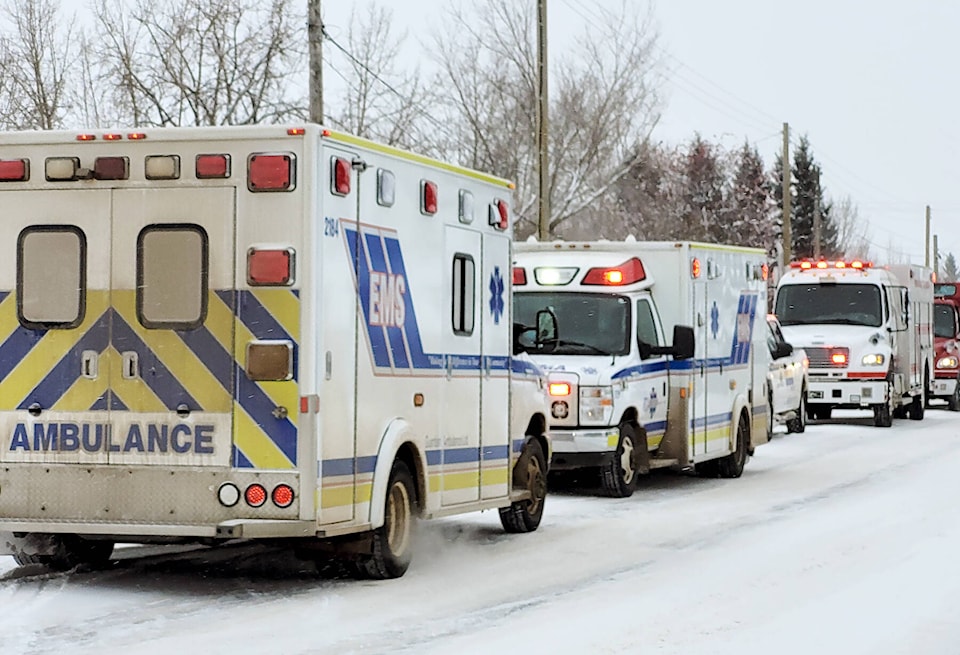By Jennifer Henderson, Local Journalism Initiative Reporter, St. Albert Gazette
Some rural communities are facing hour-long waits for ambulances as first-responder coverage becomes stretched across the province.
Last month, Alberta Municipalities, formerly known as the Alberta Urban Municipalities Association (AUMA), passed two resolutions relating to ambulance service in the province, as communities across Alberta struggle with ambulance services.
One resolution will see Alberta Municipalities advocate for a review of the emergency ambulance dispatch system, which has been centralized by Alberta Health Services. The other motion is to advocate for a plan to improve delivery and performance of the ambulance system in the province.
Areas of the province have been battling red zones, where no ambulances are available to respond to a call, and municipalities want to see changes to response times.
In Sexsmith, Mayor Kate Potter said her community has had trouble with the centralized dispatch system and response times.
Sexsmith, a community of around 2,600 people, has to wait for ambulance services to be dispatched from neighbouring Grande Prairie.
“We have struggles with proximity and the red zones that are happening across the province, where our ambulances end up getting tied up and you won’t end up getting an ambulance,” Potter said.
Thankfully, the community has volunteer firefighters who can respond to some calls, but they are limited in what they can take care of, and can’t provide consistent daytime responses, Potter said.
Before AHS centralized ambulance dispatch, Potter said response times were faster.
In one case in Sexsmith, Potter said a resident passed away while waiting for an ambulance because dispatch didn’t recognize the location the person was calling from on the map.
“The map had not been updated and the ambulance wouldn’t dispatch because they said there were no roads that lead to [the] house,” Potter said.
The woman who called was standing in her house at the time with her husband who needed immediate care next to her and the ambulance wouldn’t respond. The husband passed away while waiting for care.
Potter said a local dispatcher would be able to call give directions to somebody who is more familiar with the area.
The mayor said it can be more expensive for residents in the community to get insurance when response times increase.
“We end up being downgraded for insurance and other things, which increase your costs as residents because if you don’t have fire response and medical response with X amount of distance, your home insurance, for example, goes up significantly,” Potter said.
In Rimbey, Mayor Rick Pankiw said residents in the community have had to wait upwards of five hours for ambulance services.
“We have been having problems for months and months,” Pankiw said.
The mayor said not every call for service is a five-hour wait, but if it happens only a few times, it’s too much.
Pankiw said it is important for ambulance services to respond to care for the aging population in the community, which has the most older residents in the province.
Pankiw said there are hand-offs in the city, where local ambulances drop off residents in Red Deer, or local ambulances are sent to Red Deer because they are short on vehicles. But if someone in Rimbey then needs an ambulance, their local drivers are 45 minutes away.
In Clive, Mayor Luci Henry said council has sent letters to the province flagging the slow response times and the confusion with local rural areas from centralized urban dispatch centres.
“It does make it difficult for those response times to be good, and so we are seeing our fire departments having to be the first on the scene and then having to stay on site and tie up those services until those ambulances are being able to get there to finish up the service,” Henri said.
Clive Coun. Norma Penney said response times vary based on where the ambulance is coming from. If the ambulance is dispatched right away from Lacombe, it might arrive in 20 minutes, but if it is dispatched from Red Deer, it could be more like 40 minutes.
Overall the area just needs more ambulances, Henry said, because if there were more units based out of Lacombe, there wouldn’t be such lengthy wait times.
New Alberta Municipalities president Cathy Heron said the board hasn’t decided which of the motions passed during the fall meeting will be their biggest priority, but the fact that two resolutions focused on ambulance response times show how important the issue is.
In St. Albert, where Heron is mayor, she said she doesn’t really know the response times for local St. Albertans, because AHS will track response times for St. Albert ambulances, which may respond to calls in Edmonton, rather than response times for residents of St. Albert.
“I care about the end user; I care about the St. Albert resident,” Heron said.
The mayor said she knows the local trucks are responding to everything as fast as they can, but that might be for a call in Edmonton. Heron wants information to be tracked and released for how long St. Albert residents are waiting for medical help.
“I don’t know how long my residents are waiting for an ambulance.”
